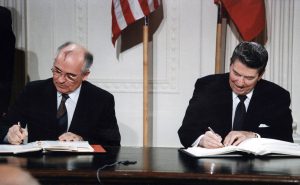BY GEORGE P. SHULTZ nytimes.com
Mr. Shultz was a secretary of state in the Reagan administration.

Nuclear weapons are a threat to the world. Any large-scale nuclear exchange would have globally catastrophic consequences. Conscious of this reality, President Ronald Reagan and Mikhail Gorbachev, the leader of the Soviet Union, worked in the 1980s to reduce the number of nuclear weapons, with the ultimate goal of getting rid of them.
The Intermediate-Range Nuclear Forces Treaty, signed in 1987, was a major step toward this goal, eliminating a large class of nuclear weapons that were viewed as particularly destabilizing. The treaty is still in force, although both the Obama and Trump administrations have said that Russia is in violation. Whatever the case, we need to preserve the agreement rather than abandon it, as President Trump has threatened to do.
Indeed, we should invite other countries to join the treaty and resist the temptation ourselves to develop new classes of these deadly weapons. The first step would be to convene a meeting between American and Russian experts to discuss possible violations of the treaty.
The treaty included many special features, not the least of which were provisions for extensive on-site inspections to verify that all prohibited missiles had been eliminated. Many doubted that such inspections would ever actually take place, but they did. By 1992, nearly 2,700 missiles had been destroyed. The inspection provisions expired in 2001, but the United States and Russia could agree to revive them to help resolve the worries about compliance.
On Oct. 19, 2017, President Vladimir V. Putin of Russia said: “If you ask me whether nuclear disarmament is possible or not, I would say, yes, it is possible. Does Russia want universal nuclear disarmament or not? The answer is also yes — yes, Russia wants that and will work for it.”
The United States’ Nuclear Posture Review, published in February, includes this statement: “The United States remains committed to its efforts in support of the ultimate global elimination of nuclear, biological and chemical weapons. It has reduced the nuclear stockpile by over 85 percent since the height of the Cold War and deployed no new nuclear capabilities for over two decades.”
Recent rhetoric has undermined the meaning of these statements, but they are part of the record, and the United States and Russia should strive to live up to them.
George P. Shultz, a distinguished fellow at Stanford University’s Hoover Institution, was the secretary of state from 1982 to 1989 and secretary of labor, secretary of the Treasury and director of the Office of Management and Budget in the Nixon administration.
